


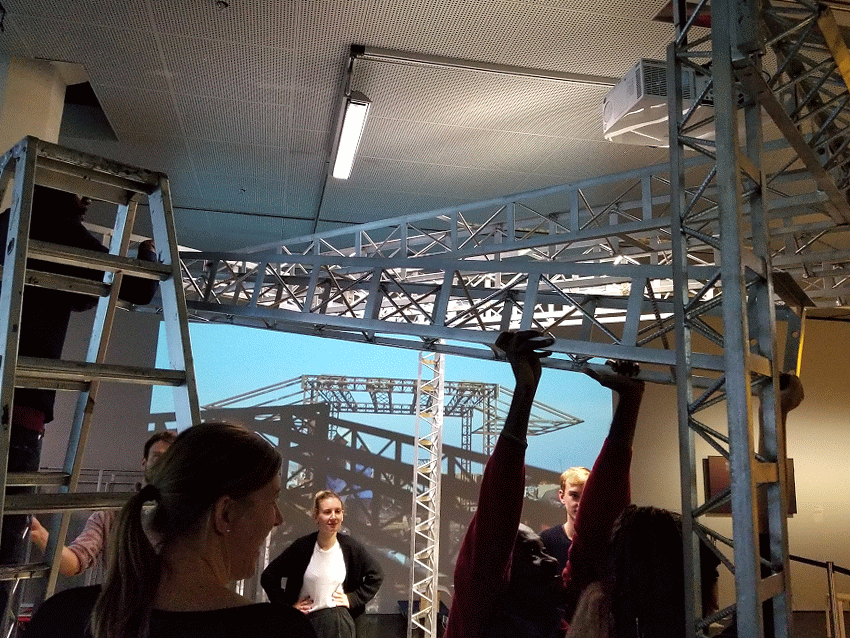





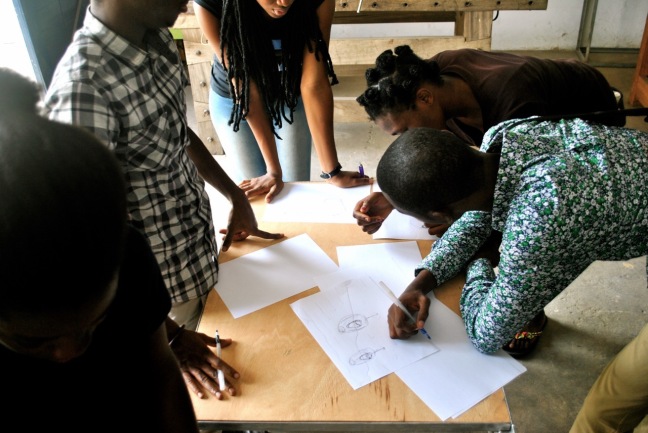
Finalists from Innovate Ghana‘s 2015 Design Challenge around problem areas of Water & Sanitation participated in a prototype design workshop at the Makerspace @Impact Hub Accra (December 19, 2015):
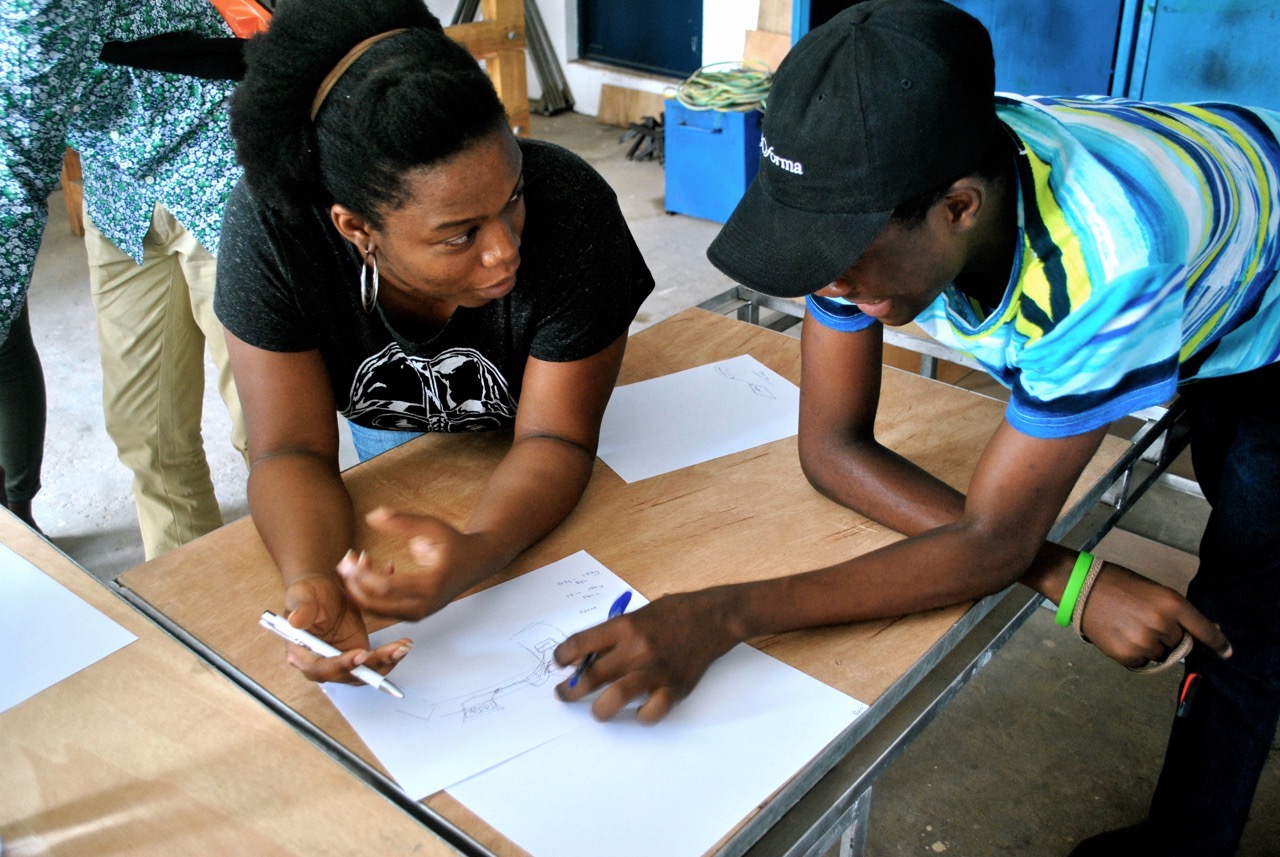
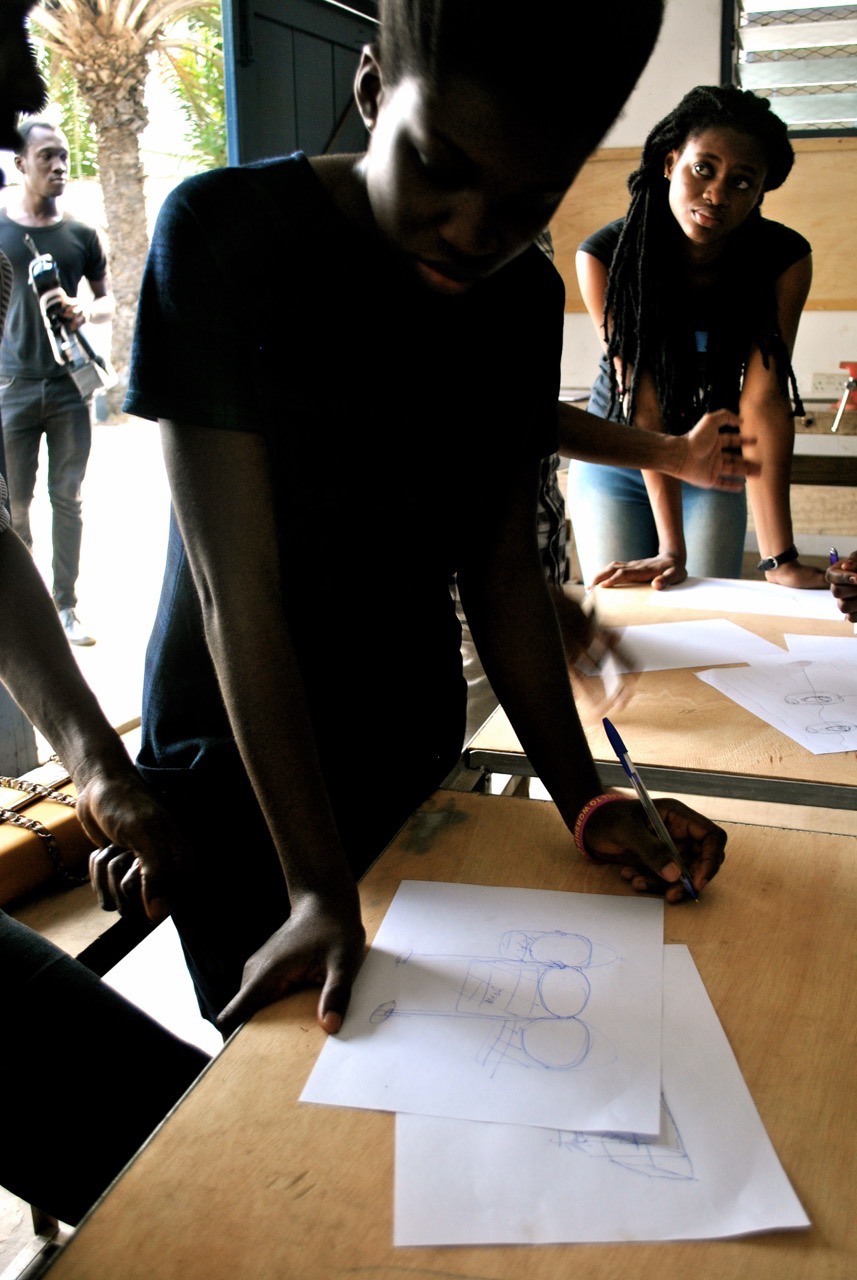
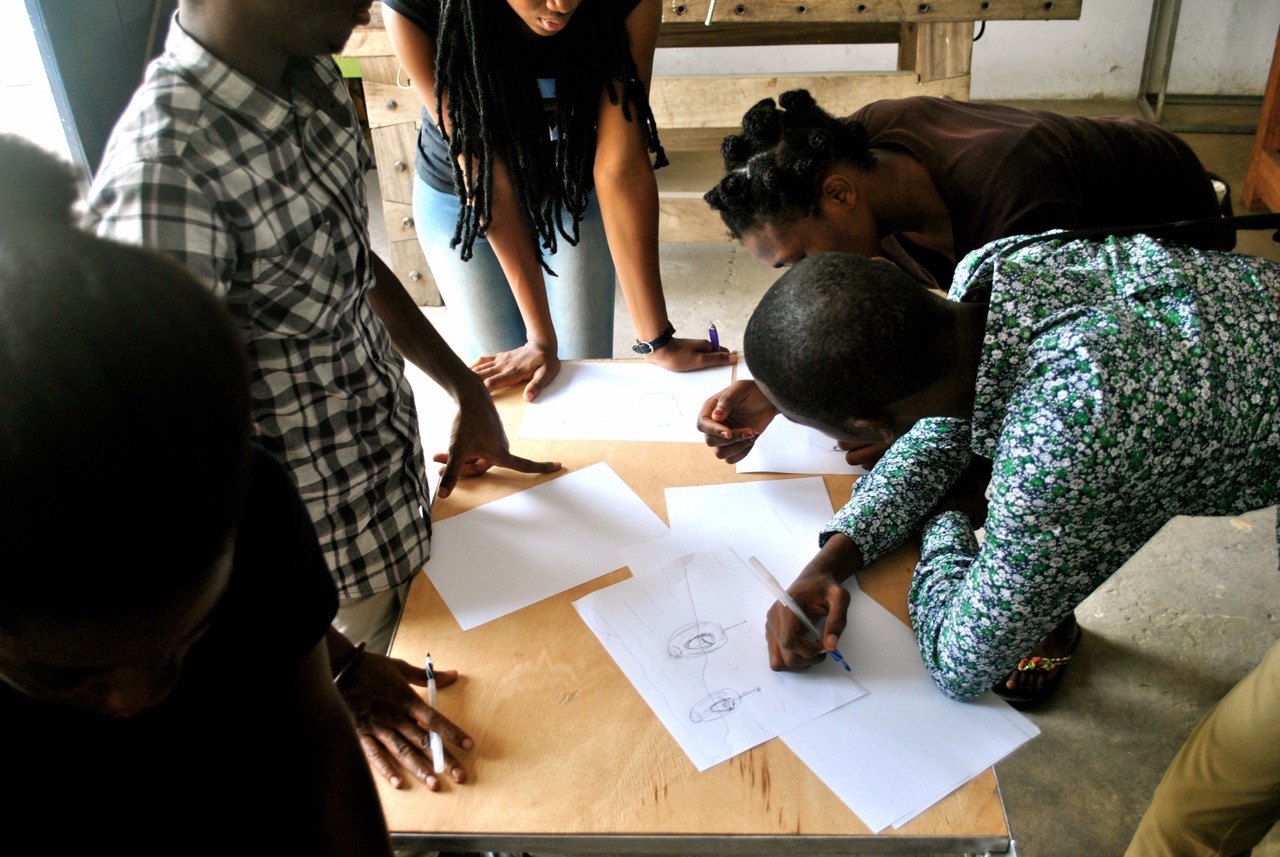
Then @kabsseidu & @afrocyberpunk showed up from Nubian VR and prototyped a VR camera rig:
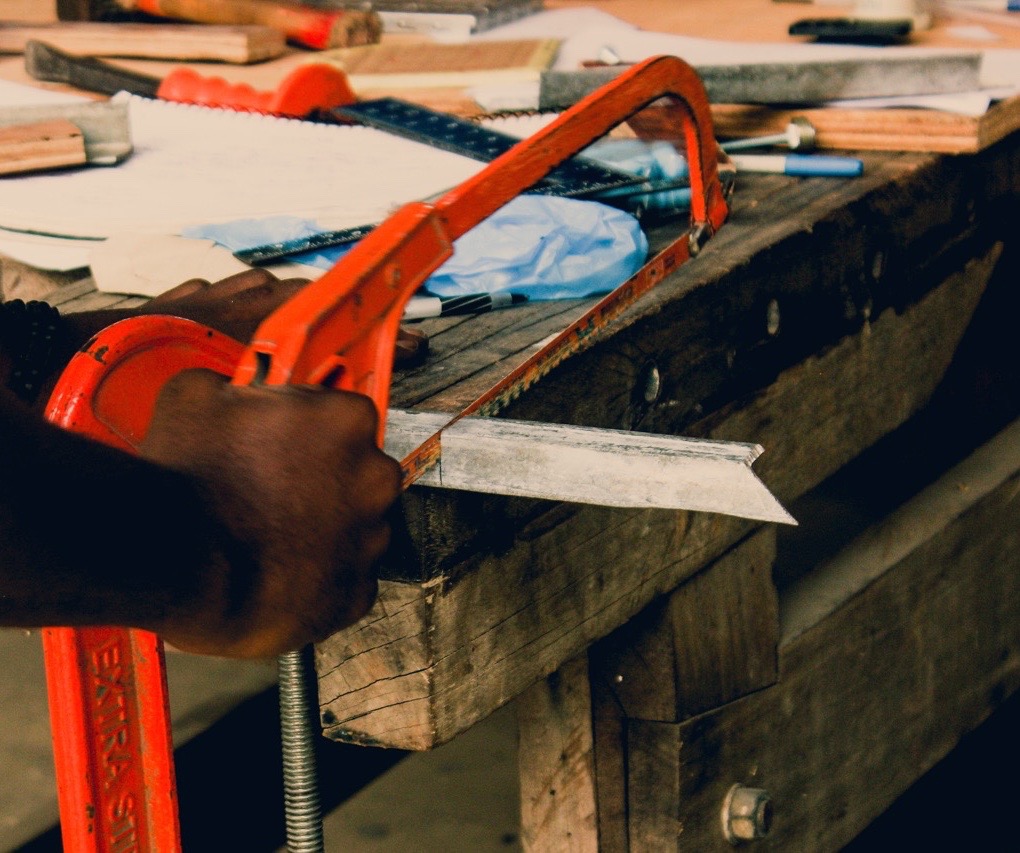
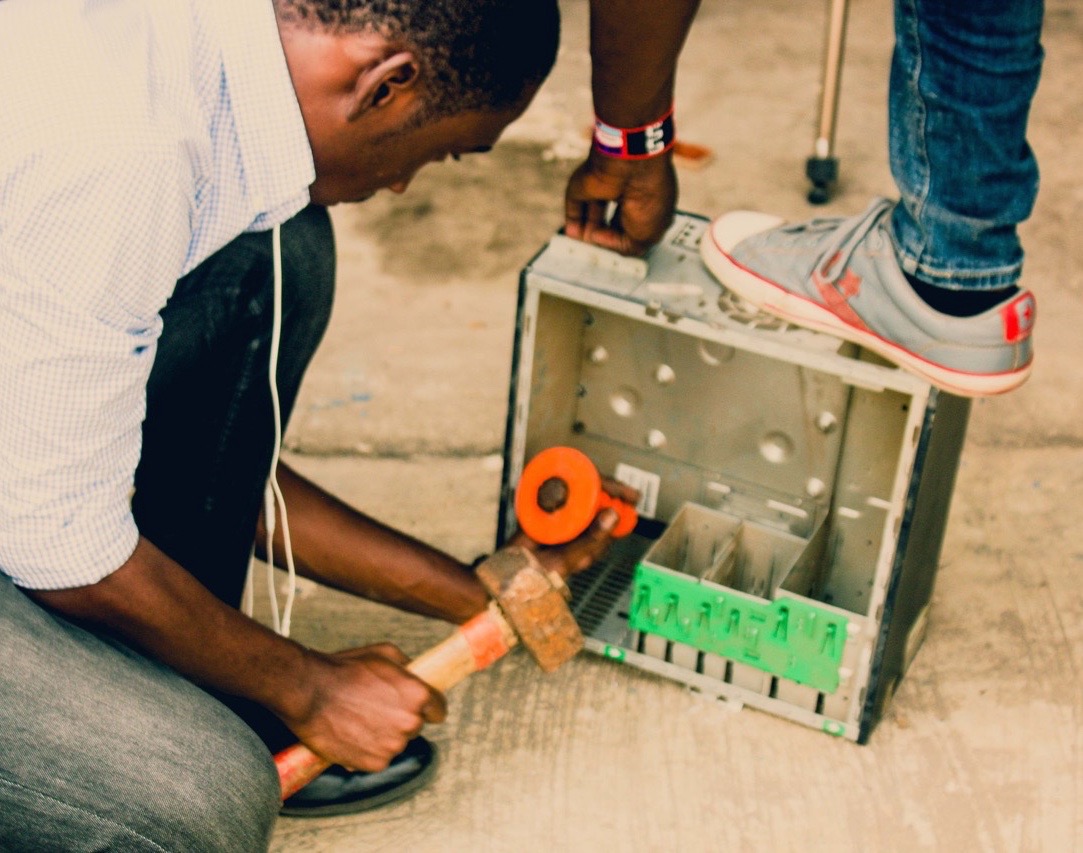
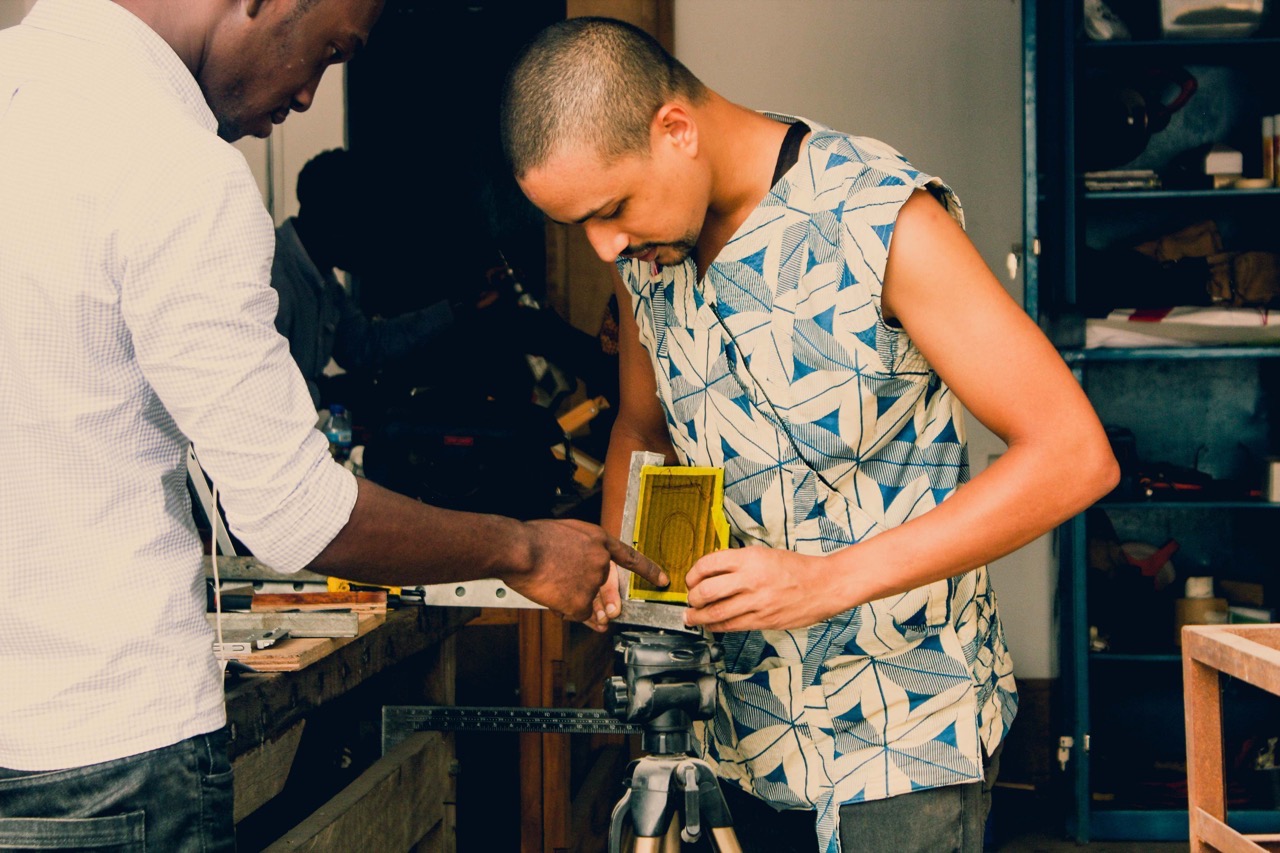


Making a mobile oven, or mini-kiln; for melting plastics originally but whatever you need to bake. Pick or make the right caster wheels for the sort of mobility mini-kiln usage requires.


Plastics constitute a significant portion of the Agbogbloshie waste stream, moving through stages of collection, sorting (by type and colour), cleaning, shredding and even in some cases molding into pellets. (See Plastics blog post). With at least 7 micro-factories by our count, Agbogbloshie is a key part of the plastic recycling industry in Ghana, and integrally interconnected with both local and global production cycles. To date, the failure of Agbogbloshie’s industrial ecosystem to add value to plastic material recycled on-site is a lost opportunity for local manufacturing.
Building on our experiments with plastic during AMPQAMP and drawing on the knowledge and expertise of oven fabricators based on the ground in Agbogbloshie, we are now co-designing and prototyping a mini-kiln. This week, William Mensah completed fabrication of the first prototype in Accra Timber Market,adjacent to Agbogbloshie. The mini-kiln fits the standard module of the AMP spacecraft and is one of the first tools from the AMP tool-set developed to plug into the community workshop.

The prototype, is composed essentially of a frame of angle bars, inner and outer layers of sheet metal with a layer of what is locally called “fibre” (PUR foam insulation sourced from air-conditioner dismantling). We didn’t finish until evening, but couldn’t wait to test. Hence using shredded plastics from Agbogbloshie, we made new recycled plastic tiles, heating the the plastics to their melting point, and allowing them to cool. We intend to carry out carry more of such low-high tech plastic experiments soon in our spacecraft. Stay tuned for more and be sure to share with us, your innovative ideas regarding plastic recycling.

Notes:
+Need to add chimney, temperature gauge, and calibrated gas control.
+Cost compare with 2-module wide unit, cylindrical drum cast concrete or clay insulated.
+Link with rotational plastics moulding machine:feedback-enabled temperature controls.

Could Agbogbloshie begin to supply low-cost upcycled computers to children in Old Fadama? Could this scope expand beyond this territory to other parts of Accra and to the under-privileged in Ghana? Could this net expand to cover the entire African continent? Imagine upcycled computers, supplied to all parts of the world from Agbogbloshie. There is a promising future for this and needs to start somewhere.
As part of engaging the Agbogbloshie community and STEAM professionals, AMP organized a ‘maker workshop’ to teach e-waste workers how to make a Jerry and install software on it. After a rainy morning, the AMP team arrived in Agbogbloshie in the afternoon. Most of the work-spaces in the scrap yard were partially flooded. Being Friday, and a majority of the e-waste workers being Muslims, they had just arrived from the Friday afternoon prayers. Since prior arrangements had been made with Sam Sandow (AMP agent in Agbogbloshie) and Zack (E-waste worker), the workshop started in one of the computer shops in Agbogbloshie located near the entertainment center. It is owned and operated by the Nigerian called ”Emeka”. The very same person from which components were sourced for the Jerry workshop in Kokrobite. The shop has shelves on which one would find hard drives, mother boards, circuit boards and many others.

Upon arrival, the team pitched tent and Daniel (AMP intern from creativity group KNUST) briefly introduced the Jerry concept to the community. After we explained the concept to Emeka, a monitor, keyboard and mouse, were made available for us to use. He also gave us a compact disc (CD) with an operating system. The team installed it and allowed the participants to familiarize themselves with the Jerry whilst interactively exchanging ideas with the AMP makers collective.
It’s highly informative and exciting to think that, these same e-waste workers who are among the most marginalized and least literate are actually computer literate- and that some of them are even self-thought. This reveals how much youthful potential is being lost to class stereotyping and the resultant marginalization.
The team later presented the concept of the Quadcoper to the workers by Samuel Amoako (AMP intern and student from KNUST). It was then flown on the football field to demonstrate how it will help AMP map Agbogbloshie and also monitor air pollution levels.

All through history, some of the most fascinating discoveries have come about as a result of conversations between two unlikely parties or people from highly divergent backgrounds who would ordinarily not interact. The creation of a community space where such interaction can happen and spark new genius via the crafting of the ground breaking ideas and objects is one of the central objectives of AMP.
As usual, the workers were busy with their activities: dismantling, loading trucks with scrap metals etc… but some were able to spend time with us and expressed their interest in making one themselves. One of the common questions asked was..whether the plastic will melt when the computer overheats? We answered them by discussing the physical properties of the type of plastic used, such as its melting temperature which is about 130oC and it’s combustion point which is between 340oC to 380oC. Another major concern was the market for the product and the price one should be sold. In effect they appreciated the fact that, parts of old computers can be sourced and used to make a server that works and are cheaper. The AMP team hopes to transfer the knowledge in assembling Jerry computer to making a Jerry Laptop (‘JerryTop’) in the near future.
Agbogbloshie is a challenging site. As a space, Agbogbloshie is sensory overload: soil and water darkened from pollution exude noxious vapours under the heat of the sun; toxic fumes emanate from burning sites; the clamour of slamming hammers and banging chisels fills the air… But that is only part of the Agbogbloshie story.
A closer look at the ecosystem of the giant self-organized open-air factory shows that Agbogbloshie is about more than destruction alone. A parallel set of activities support the livelihood of onsite workers: food and entertainment spaces — Agbogbloshie has both a cinema and foosball tables! Numerous mosques dot the landscape (we found a total of 14 mosques in the area surveyed) serving five times a day the faithful that are working nearby. Since believers must take ablution before praying, water circulates in plastic tea pots from water tanks, the few municipal water supplies and public toilets/showers that are sprinkled around the site. Workers also engage in making: making tools (such as chisels) to disassemble e-waste or other items into scrap that has a resalable value, making machines (such as a furnace blowing system using a bicycle wheel) to make these tools, and making items (aluminum pots and coal pots using metals harvested from refrigerators) to sell outside the boundaries of the site.

We love the hand-crafted bicycle tyre-powered blowers used to ventilate locally-fabricated furnaces for cottage industry smelters (seen in various places). They are a powerful example of the on-going knowledge transfer within Agbogbloshie and testament to the intertwined nature of making and technology development. Exactly what AMP seeks to further leverage in Agbogbloshie.
Here is the link to our Flickr album Made in Agbogbloshie. While (e-)waste processing is crude and hasty to maximize profit (informal e-waste workers earn a higher than average income compared to informal workers overall), we certainly see all the parts necessary to make the machine, the self-organized open-air factory, run smoothly. Making is just part of it.

One of AMP’s core objectives is the compilation and design of a “waste” electronic and electrical equipment (WEEE) manual. The main purpose of this is the provision of vital information for the AMP maker collective comprising of STEAM students/graduates (Science, Technology, Engineering, Art and Mathematics) and Agbogbloshie e-waste workers.
For several months, we worked on the print version of the manual–a series of individual manuals for each electrical and electrical equipment studied–which has undergone several design iterations (see image below). We collected data from a number of articles and our own fieldwork (to learn the value in Ghana Cedis of each item brought to and dismantled in Agbogbloshie). We designed a manual for each piece of equipment studied so it fits a single folded sheet of paper. This makes it simpler and more user friendly. In the coming days, these manuals as they are so far, will be hosted online so makers and people knowledgeable about electrical and electronic equipment could contribute to them.
The manual is organized so as to give information on material composition, parts and components, hazardous materials, urban mining opportunities, tools for dis-assembly, steps for dis-assembly, safety gear, and opportunities and ideas for remaking.
 Picture of the AMP Team showing the manual to Svet from the Lightyear Foundation.
Picture of the AMP Team showing the manual to Svet from the Lightyear Foundation.
This task is a staggering one because it should cater to the needs of people pertaining to different social categories, each with different understanding and knowledge. On the one hand are the STEAM professionals, educated and used to reading guides and who may even love manuals and on the other hand, the e-waste workers, predominantly uneducated and having a general disinclination towards anything remotely related to guidebooks or for that matter, books. This means they would both relate differently to a typical guidebook. Although this may sound stereotypical, it is a truth with which the AMP team is confronted.

To navigate these murky waters, the team decided to go beyond the traditional printed manual in a foreign language and to in addition to this make to video manuals which can be housed on servers and broadcast inside the spacecraft. These will be targeted specifically at the e-waste workers, and put together by some of them, in collaboration with their STEAM counterparts and will be done in Dagbani ( the Lingua franca as it were in Agbogbloshie). In addition to this, makers and/or hackers around the country and the world will have access in open source fashion to all the manuals online, as part of the AMP digital platform.

In the coming years, AMP hopes to see this manual evolve into a highly informative periodical, providing vital knowledge for a local and international network of young passionate makers and hackers. A thrilling thought indeed!!!

Agbogbloshie e-waste dump as it is known, and portrayed by the media is more than just that. It is an e-resource repository; a source of valuable raw e-material and a makers’ paradise. On this e-turf, there are several players, whose operations make it what it is.
Zack is a young e-waste worker. He usually operates in the Agbogbloshie refrigerator trade: buying, selling, dismantling and selling again. The AMP team encountered him over 7 months ago and signed him on as a part of the AMP maker collective.

“Emeka” is a Nigerian migrant to Ghana. He owns and operates a shop out of Agbogbloshie. The shop is well stocked and has a CCTV camera which helps him secure his “goods”. Though the team had been to this side of Agbogbloshie, this was the first time we were meeting him in person.
What do all these people have in common? Computers!!
As part of the AMPQAMP at the Kokrobite Institute, AMP hackers and/or STEAM students and graduates, collaborated with hackers from the Woelab (Togo’s very active makerspace!) to build a Jerry. A Jerry is a computer that is made with parts from old computers assembled in a jerrycan. This workshop was significant, mainly due to the transfer of knowledge which occurred during the assembly process. As part of this highly didactic process, a team comprising makers from both AMP and Woelab visited Agbogbloshie.
Inside Agbogbloshie, the team first encountered a computer shop. It was well stocked and able to provide a wide range of old computer parts owned and run by Emeka. During the interviews and interaction with the e-waste workers in Agbogbloshie, the AMP team discovered that, Nigerians formed a critical part of the ecosystem in Agbogbloshie. A network that virtually spans the entire globe.
Subsequently, the team met with Zack, an e-waste worker, who is part of the AMP maker collective. Several weeks earlier, the AMP team had discovered much to our surprise that Zack whom we knew only as an expert in the commerce and dismantling of old fridges in Agbogbloshie and who had helped us with our workshop in fridge disassembly, was also a self taught computer repairer. He was comfortable enough to ask us which parts we needed, and proceeded to test them for us by connecting each in turn to his personal computer. The level of fruitful interaction had with him, points to the phenomenal possibilities that a fully operational maker collective (comprising STEAM professionals and e-waste workers) in Agbogbloshie would unleash.
Back at the Kokrobite institute, the Woelab team, led by Rhode Audrey and Martine Pandam together with the AMP team led by Daniel started to assemble the Jerry computer. We first produced schematic sketches and then marked out and cut the JerryCan. We then placed the components: first the mother board, then the hard drives, then the cables, the power pack and finally the CD-ROM. In all, it was a very exciting experience. The excitement has spurred the AMP team on to explore further design possibilities. The team is advancing ideas such as the solar JerryTop: recovered laptop parts in a Jerrycan powered by recovered solar cells.

These we believe can serve as a means of providing cheap computers in rural areas and in deprived urban contexts and can go a long way to improve computer literacy in Ghana and Africa as a whole. This is one of those projects where hackers like Zack in Agbogbloshie and STEAM professionals like Daniel from the creativity group in KNUST (Kwame Nkrumah University of Science and Technology) could collaborate. In the few moments where language was a barrier, both teams communicated via the language of computers and making, which are both universal. Thanks to Yasmine (AMP co-pi) and Rejoice ( psychology intern and maker), such moments were minimized, as they took turns to translate.
In the end, there was a handing over ceremony where the team from Togo handed over the Jerry’s to the AMP team, signifying a transfer of technology.


#ampqamp14 ran June through August, 2014 at the Kokrobitey Institute, Hub Accra (now Impact Hub Accra) and the Agbogbloshie scrapyard, in collaboration with Togo’s Wɔɛlab. #ampqamp14 focused on M&D (Makers & Development, a practical hands-on approach to R&D) for the spacecraft, while #ampqamp15 focused on codesign of the AMP app.
Participants included:
| Name | Area of specialisation | Institution |
| Michael ACQUAH | Physics | University of Cape coast |
| Divine KWAME | Communication design | University of Cape coast |
| Maame Amma ANINKORA | Physics | University of Ghana |
| Rejoyce DOUMON | Psychology | University of Ghana |
| Louis BADOE | Medicine | University of Ghana |
| Nutifafa Yao DOUMON | Teaching Assistant, Physics | University of Ghana |
| Etornam AVOUGLA | Graduate (Maths & Statistics) | University of Ghana |
| Samuel AMOAKO-FRIMPONG | Aerospace engineering | Kwame Nkrumah University of Science & Technology |
| Daniel Henneh ADU | Electrical engineering | Kwame Nkrumah University of Science & Technology |
| Timothy AFFRAM | Mechanical Engineering | Kwame Nkrumah University of Science & Technology |
| Leonce Olorode ATANLEY | Electrical Engineering | Kwame Nkrumah University of Science & Technology |
| Martine PANDAM | Maker | WOELAB Togo |
| Kokou Dieudonnei AYEBUA | Maker | WOELAB Togo |
| Yannick MENSAH | Maker | WOELAB Togo |
| Rhodes O. AUDRE | Maker | WOELAB Togo |
| Kakatsi K.E. TEDO | Maker | WOELAB Togo |
| Lena KORSAH | Designer | Kokrobitey Institute |
| Natalie FORDWOR | Programs Manager | Kokrobitey Institute |
| Chamil MADHAWA | Production Manager | Kokrobitey Institute |
| Renee NEBLETT | Art Education | Kokrobitey Institute |
| Rafa FONT (Recyhub) | Sustainable development | Royal Holloway, University of London |
| Mawuena BANINI | Architecture | Central University College |
| Emmanuel Kusi OFORI-SARPONG | Architecture | Kwame Nkrumah University of Science & Technology |
| Kuukuwa MANFUL | Architecture | Kwame Nkrumah University of Science & Technology |
| Ivy ASUO | Physics and Materials Science | Kwame Nkrumah University of Science & Technology |
| Yasmine ABBAS | Design & Architecture | AMP co-founder |
| DK OSSEO-ASARE | Design & Architecture | AMP co-founder |